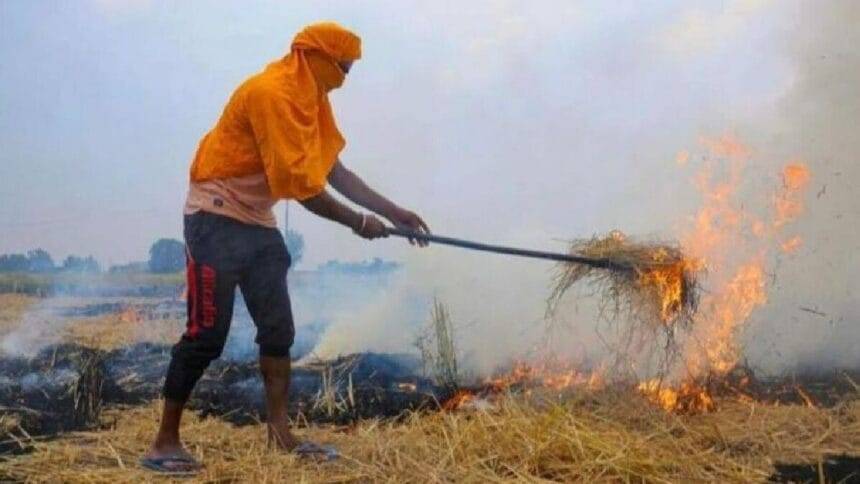Main Points In Hindi (मुख्य बातें – हिंदी में)
दिल्ली-एनसीआर में वायु प्रदूषण पर मुख्य बिंदु:
-
किसानों को दोष देना: दिल्ली के लोग विशेष रूप से किसानों को प्रदूषण का दोषी मानते हैं, लेकिन डाटा के अनुसार, पराली जलाने का योगदान केवल 3.34 प्रतिशत है, जो कि पहले 5.5 प्रतिशत और 14.6 प्रतिशत था। यह दिखाता है कि प्रदूषण के लिए किसानों को अकेले दोषी ठहराना उचित नहीं है।
-
मौसमी प्रभाव: अक्टूबर-नवंबर के दौरान दिल्ली में बढ़ते प्रदूषण का एक महत्वपूर्ण कारण मौसम की स्थिति है। हवा की गति में कमी और आर्द्रता में वृद्धि प्रदूषण को बढ़ाते हैं। अगर हवा की गति तेज होती, तो स्थिति खराब नहीं होती।
-
वायु गुणवत्ता सूचकांक (AQI): सीपीसीबी के अनुसार, हवा की दिशा में परिवर्तन से AQI में सुधार हुआ है। हाल ही में, हवा की दिशा बदलने से प्रदूषण स्तर में गिरावट देखी गई, लेकिन अगर हवा की दिशा फिर से बदलती है, तो प्रदूषण फिर बढ़ सकता है।
-
दीवाली पर संकट: दीवाली के आसपास, उत्तर-पश्चिमी हवाएं प्रदूषकों को दिल्ली में लाएंगी, जिससे वायु गुणवत्ता "गंभीर" श्रेणी तक पहुँच सकती है। केंद्र के पूर्वानुमान के अनुसार, AQI 401 से 500 के बीच हो सकता है।
- स्थायी समाधान की आवश्यकता: मौसमी और मानवीय गतिविधियों के संयोजन से प्रदूषण बढ़ता है। इससे निपटने के लिए गंभीर कदम उठाने की आवश्यकता है, जैसे कि शिकायतों के बजाय समाधान खोजना और सभी कारणों की पहचान करना।
Main Points In English(मुख्य बातें – अंग्रेज़ी में)
Here are the main points from the text regarding pollution in Delhi-NCR before Diwali:


-
Stubble Burning Contribution: The contribution of stubble burning to Delhi’s PM 2.5 pollution levels is relatively low, with recent statistics showing it was just 3.34% on a specific Sunday and peaked at only 15.97% on October 23. Despite these numbers, residents continue to blame farmers for pollution.
-
Weather Conditions Impact: Weather conditions significantly affect pollution levels in Delhi-NCR, as increased humidity and decreased air flow contribute to higher pollution. Improved air quality has been observed when changing wind patterns bring in cleaner air.
-
Air Quality Index (AQI) Fluctuations: The AQI in Delhi has shown considerable improvements due to changing wind patterns, with decreasing average AQI values indicating temporary relief from pollution. However, many monitoring stations still recorded ‘very poor’ air quality.
-
Projected Future Pollution: Meteorologists predict that the change in wind direction around Diwali may exacerbate pollution levels due to the influx of pollutants from stubble burning in northern states, combined with the expected use of firecrackers.
- Short-Term Relief: The current decrease in pollution is seen as a temporary improvement, with forecasts suggesting conditions may worsen around the Diwali festival, likely leading to ‘severe’ air quality levels.
Complete News In Hindi(पूरी खबर – हिंदी में)
दिल्ली-एनसीआर दीपावली से पहले प्रदूषण का सामना कर रहा है। इस पर दिल्ली के लोग किसानों को बुरे ठहरा रहे हैं। लेकिन किसी को दोष देने से पहले हमें आंकड़ों पर भी ध्यान देना चाहिए। केन्द्र के निर्णय सहायता प्रणाली (डीएसएस) के आंकड़ों के अनुसार, रविवार को दिल्ली में पराली जलाने का योगदान PM 2.5 में केवल 3.34 प्रतिशत था। शनिवार को यह लगभग 5.5 प्रतिशत और शुक्रवार को 14.6 प्रतिशत था। इस मौसम में, 23 अक्टूबर को पराली का अधिकतम योगदान PM 2.5 में केवल 15.97 प्रतिशत था। फिर भी, लोग सिर्फ किसानों को ही इस प्रदूषण के लिए दोषी ठहरा रहे हैं।
अक्टूबर-नवंबर में दिल्ली-एनसीआर में बढ़ते प्रदूषण का एक बड़ा कारण मौसम की स्थिति भी है। हवा की गति कम होती है और नमी बढ़ती है। अगर हवा की गति तेज होती, तो स्थिति इतनी खराब नहीं होती। एक रिपोर्ट के अनुसार, केंद्रीय प्रदूषण नियंत्रण बोर्ड (सीपीसीबी) का डेटा बताता है कि सोमवार को दक्षिण-पूर्वी सतही हवाओं के कारण दिल्ली में प्रदूषण स्तर में सुधार हुआ है। इसके चलते यहां का वायु गुणवत्ता सूचकांक (AQI) “खराब” श्रेणी में गिर गया, जबकि एक दिन पहले यह “बहुत खराब” श्रेणी में था। इसका मतलब है कि जब हवा की दिशा बदलती है, तो पराली से होने वाला प्रदूषण कम हो जाता है। फिर भी, लोग किसानों को ही दोष दे रहे हैं।
यह भी पढ़ें: कारखानों और शहरीकरण के कारण भूजल संकट बढ़ा… केवल धान को ही क्यों बदनाम किया गया?
हवा ने बदल दी स्थिति
बोर्ड के अनुसार, सोमवार को सुबह 4 बजे दिल्ली का 24-घंटे का औसत AQI 304 (बहुत खराब) था। शाम 6 बजे यह 299 (खराब) और रात 10 बजे 288 हो गया। पिछले रविवार को 4 बजे का औसत AQI 356 (बहुत खराब) था। सोमवार का औसत AQI दिल्ली में 40 वायु गुणवत्ता निगरानी स्टेशनों में से 36 के डेटा पर आधारित था। इनमें से 21 स्टेशन ‘बहुत खराब’ श्रेणी में थे, जिसमें बुरारी स्टेशन (365) सबसे खराब था। AQI यदि 301 से 400 के बीच है, तो इसे ‘बहुत खराब’ श्रेणी में माना जाता है, जबकि यदि यह 201 से 300 के बीच है, तो इसे ‘खराब’ माना जाता है।
मौसम विशेषज्ञ ने क्या कहा?
स्कायमेट मौसम विज्ञान के उपाध्यक्ष महेश पलावत ने बताया कि दिल्ली में AQI में सुधार दक्षिण-पूर्वी हवाओं के कारण है, जो 10-18 किलोमीटर प्रति घंटे की गति से चल रही हैं। “हमने 26 अक्टूबर को हवा की दिशा में बदलाव देखा और पराली जलाने का स्तर कम हो गया। रविवार और सोमवार को स्थानीय हवा की गति 10-18 किलोमीटर प्रति घंटे थी, हालांकि मंगलवार से यह कम हो गई,” उन्होंने कहा। पलावत ने कहा कि दीवाली के समय हवा की दिशा फिर से बदल सकती है, जिससे पराली का प्रभाव फिर से बढ़ सकता है।
आराम कितना समय तक रहेगा?
हालांकि, यह राहत केवल थोड़े समय के लिए है, क्योंकि दीवाली के आसपास दिल्ली में दोहरी मार पड़ने की संभावना है। हवा की दिशा उत्तर-पश्चिमी होने की उम्मीद है, जिससे उत्तरी राज्यों में खेतों में आग लगने वाले प्रदूषक आएंगे। दीवाली पर पटाखे फटने की संभावना के कारण, केन्द्र की प्रारंभिक चेतावनी प्रणाली (EWS) ने भविष्यवाणी की है कि राजधानी में वायु गुणवत्ता “गंभीर” श्रेणी तक पहुँच सकती है। यदि AQI 401 से 500 के बीच है, तो इसे ‘गंभीर’ श्रेणी में माना जाता है।
यह भी पढ़ें: कम उत्पादकता के कारण किसान, उपभोक्ता और वस्त्र उद्योग सभी चिंतित हैं, कौन जिम्मेदार?
Complete News In English(पूरी खबर – अंग्रेज़ी में)
Delhi-NCR is being hit by pollution before Diwali. For this, people of Delhi are especially busy in making the farmers villains. But, before putting anyone in the dock, we should also see what the statistics say. Data from the Centre’s Decision Support System (DSS) showed that the contribution of stubble burning to Delhi’s PM 2.5 on Sunday was only 3.34 percent. It was around 5.5 percent on Saturday and 14.6 percent on Friday. This season, the maximum contribution of stubble in Delhi’s PM 2.5 was on October 23, that too only 15.97 percent. Despite this, the people of Delhi are only blaming the farmers for this pollution.
Weather conditions are also a major reason for increased pollution in Delhi-NCR during October-November. Humidity increases and air flow decreases. Otherwise there would have been an uproar even if wheat stubble was burnt. If the wind speed is fast then the situation will not be so bad. A report has come confirming this. According to Central Pollution Control Board (CPCB) data, there was a significant improvement in Delhi’s pollution level due to south-easterly surface winds on Monday. Due to which the Air Quality Index (AQI) here fell into “poor” category a day after reaching “very poor” category. That means, if the wind direction changes, the stubble pollution reduces. Despite this, the people of Delhi blame the farmers only.
Read this also: Ground water crisis increased due to factories and urbanization… Why only paddy got infamous?
The wind changed the situation
According to the board, the 24-hour average AQI of Delhi at 4 pm on Monday was 304 (very poor). By 6 pm it became 299 (bad) and at 10 pm it became 288. In comparison, the average AQI at 4 pm on Sunday was 356 (very poor). The average AQI on Monday was calculated based on data from 36 out of 40 air quality monitoring stations in Delhi. Of these, 21 stations were in the ‘very poor’ category, with Burari station (365) being the worst, followed by Mundka (348). If AQI is between 301 to 400, it is considered to be in the ‘very poor’ category, whereas if it is less than that i.e. between 201 to 300, then the air quality of that area is considered to be ‘poor’.
What did the meteorologist say?
Skymet Meteorology Vice President Mahesh Palawat told HT that the improvement in AQI in Delhi is due to south-easterly winds at a speed of 10-18 kilometers per hour. “We saw the wind direction changing from north-westerly on October 26 and the extent of stubble burning reduced. The local wind speed, which was 10-18 km per hour during the day on Sunday and Monday, decreased from Tuesday onwards,” he said. Palawat said that the wind direction is also expected to change by Diwali, due to which the effect of stubble may increase again.
How long will the relief last?
However, this relief is going to last only for a short time, because there is a possibility of a double blow in Delhi around Diwali. The wind direction is likely to be north-westerly, which will bring pollutants from farm fires in the northern states. With the possibility of bursting of crackers on Diwali, the Centre’s Early Warning System (EWS) for Delhi has predicted that the air quality in the capital will reach the “severe” category. If AQI is between 401 to 500 then it is considered in ‘severe’ category.
Read this also: Farmers, consumers and textile industry are all worried due to low productivity of cotton, who is responsible?






